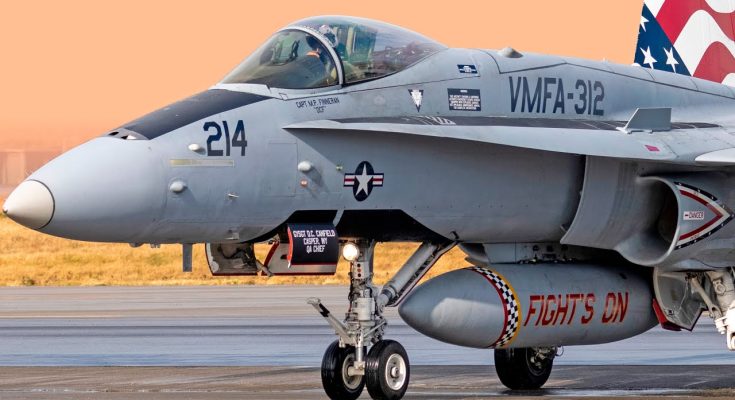U.S. Marine Corps F/A-18 Fighter Squadron Begins Flight Operations in Northern Japan
The U.S. Marine Corps recently began flight operations in Northern Japan, marking a significant milestone in enhancing the United States’ military presence and operational readiness in the Indo-Pacific region. The F/A-18 Hornet fighter squadron, stationed at Marine Corps Air Station Iwakuni, is playing a vital role in supporting U.S. military objectives and reinforcing regional security commitments, especially in the face of growing tensions in the area. This deployment underscores the importance of joint exercises, forward-deployed military assets, and the U.S. military’s commitment to maintaining peace and stability in the region.
F/A-18 Hornet: Versatile Multirole Aircraft
The F/A-18 Hornet is a multirole fighter capable of conducting air-to-air combat, air-to-ground strikes, reconnaissance, and close air support. Originally designed by McDonnell Douglas (now part of Boeing), the F/A-18 is renowned for its versatility and has been the backbone of both the U.S. Navy and Marine Corps aviation units for decades.
- Role: Multirole Fighter (Air-to-Air, Air-to-Ground, Close Air Support)
- Crew: 1 (Single-seat) or 2 (Two-seat variant)
- Top Speed: Mach 1.8 (1,190 mph or 1,915 km/h)
- Combat Radius: 400-500 nautical miles (740-930 km), depending on the mission configuration
- Armament:
- Air-to-air missiles: AIM-7 Sparrow, AIM-120 AMRAAM
- Air-to-ground missiles: AGM-65 Maverick, Joint Direct Attack Munition (JDAM)
- Bombs: Mk 82/84 series, precision-guided munitions
- 1 × M61A1 Vulcan Gun (20mm)
- Avionics: Advanced radar, infrared targeting, and GPS-guided targeting pods
The F/A-18 is a crucial asset for U.S. forces in the Pacific, capable of performing a wide range of missions from air superiority to precision strikes against ground targets. Its ability to operate from both land-based airfields and aircraft carriers makes it an indispensable component of the U.S. Navy and Marine Corps air wings.
Strategic Importance of Northern Japan
Northern Japan, with its proximity to key regional hotspots like North Korea, China, and Russia, serves as a critical location for projecting military power in the Indo-Pacific. By positioning F/A-18 fighter squadrons in this region, the U.S. Marine Corps enhances its ability to quickly respond to regional threats and participate in joint operations with regional allies, such as Japan and South Korea. The strategic location of Japan also provides a forward-deployed base for U.S. forces, ensuring rapid mobility and flexibility.
The operational presence of U.S. fighter jets in northern Japan also highlights the U.S. commitment to upholding the security framework in the region, particularly in the face of North Korea’s missile tests and China’s growing military influence. In addition, it reassures U.S. allies that they can rely on American airpower to deter aggression and maintain stability in the region.
Joint Exercises and Regional Cooperation
This deployment also strengthens the U.S.-Japan alliance through joint exercises and training operations. U.S. Marines and the Japan Self-Defense Forces (JSDF) regularly conduct combined training, allowing both nations to enhance their interoperability and operational effectiveness. These exercises often include simulated air-to-ground and air-to-air combat scenarios, which help improve coordination between forces and ensure readiness in a real-world conflict.
Moreover, the U.S. Marine Corps’ presence in Japan aligns with the broader Indo-Pacific Strategy of strengthening military partnerships with regional powers like Japan, Australia, and South Korea. By demonstrating the ability to rapidly deploy aircraft and personnel, the U.S. underscores its commitment to deterrence, ensuring that any potential adversaries understand the capabilities of U.S. forces in the region.
Enhanced Readiness and Force Projection
The forward-deployed F/A-18 squadron in Northern Japan plays a critical role in maintaining the U.S. military’s readiness to respond to various contingencies. The aircraft’s ability to quickly launch from Japanese airbases provides the U.S. with an immediate response capability to threats that may arise in the region. Furthermore, the ongoing flight operations showcase the U.S. Marine Corps’ ability to conduct sustained operations from forward positions, ensuring flexibility and rapid force projection when necessary.
With the F/A-18’s multirole capabilities, the squadron can be quickly re-tasked based on evolving operational needs, whether it’s conducting air defense operations, providing close air support for ground forces, or engaging in precision strikes against enemy targets.
Conclusion
The deployment of the F/A-18 Hornet fighter squadron in Northern Japan is a clear demonstration of the U.S. commitment to regional security and its ability to maintain air dominance in the Indo-Pacific region. This operation highlights the importance of maintaining a robust, forward-deployed military presence capable of quickly responding to potential threats. By continuing to strengthen alliances and engage in joint operations, the U.S. and its allies will remain well-positioned to address regional challenges and deter aggression in a strategically critical area of the world.



